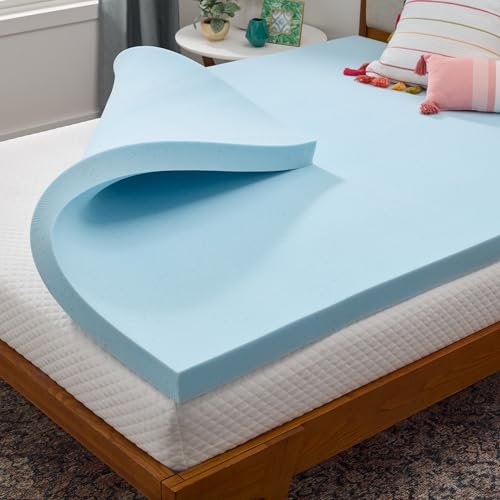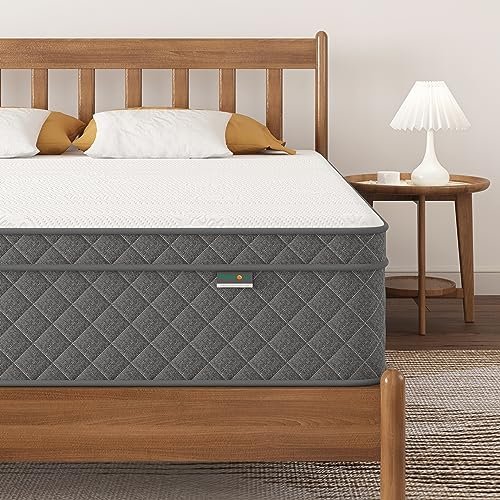What Bed Frame Should I Get? Your Ultimate Guide to Choosing the Perfect Foundation
Recommended Product:
Choosing a new bed frame might seem like a straightforward task, but with so many options available, it’s easy to feel overwhelmed. Your bed frame isn’t just a piece of furniture; it’s the foundation for your mattress, a crucial element of your bedroom’s aesthetic, and a key player in your overall sleep quality.
Don’t worry, you’re not alone in asking, “What bed frame should I get?” This detailed guide is here to walk you through every consideration, helping you make an informed decision that you’ll love for years to come. Let’s dive in!
Why Your Bed Frame Choice Matters More Than You Think
Before we get into the nitty-gritty, let’s quickly understand why dedicating time to choosing the right bed frame is so important:
- Mattress Support & Longevity: The right frame provides the essential support your mattress needs to perform its best and last its intended lifespan. Improper support can lead to sagging, discomfort, and premature wear.
- Comfort & Sleep Quality: A sturdy, noise-free frame contributes to a more stable and peaceful sleep environment. No one wants creaks and wobbles disturbing their rest!
- Bedroom Aesthetics: Your bed is often the focal point of your bedroom. The frame significantly impacts the room’s style, mood, and overall design.
- Functionality: Many frames offer practical benefits like storage, adjustability, or ease of cleaning, enhancing your daily living.
Step-by-Step Guide: How to Choose the Perfect Bed Frame
Let’s break down the decision-making process into manageable steps.
Step 1: Assess Your Mattress – It’s the Boss!
The type of mattress you own (or plan to buy) is the absolute first thing to consider. Different mattresses require different types of support.
- Memory Foam & Latex Mattresses: These often require a solid, flat surface or closely spaced slats (typically no more than 2-3 inches apart) to prevent sagging and ensure proper support. A platform bed frame is usually ideal.
- Innerspring & Hybrid Mattresses: While some hybrids can work on platform beds, traditional innerspring mattresses often benefit from or require a box spring or foundation for optimal support and airflow. If you have one of these, you’ll need a frame designed to accommodate a box spring.
- Adjustable Bases: If you use or plan to use an adjustable base, you’ll need a frame that can accommodate it. Some frames are designed to hold an adjustable base within their structure, while others simply surround the base with a headboard, footboard, and side rails.
Key takeaway: Always check your mattress manufacturer’s warranty and support requirements before buying a frame. Using the wrong frame can void your warranty and damage your mattress.
Step 2: Measure Up Your Space – Room Dimensions Are Crucial
Don’t fall in love with a king-sized frame only to find it swallows your entire bedroom!
- Measure your room! Note down the length and width.
- Consider walkways: Ensure there’s enough space around the bed to comfortably walk, open doors, and access other furniture (dressers, nightstands).
- Doorways and staircases: Remember to measure any entry points the frame will need to pass through during delivery and assembly. Some larger frames might not fit.
- Ceiling height: If you’re considering a tall canopy or four-poster bed, make sure your ceiling can accommodate it without feeling cramped.
Key takeaway: A little measuring now saves a lot of hassle later. Leave at least 2-3 feet of clearance on the sides and foot of your bed if possible.
Step 3: Define Your Style & Aesthetic – What’s Your Vibe?
Your bed frame is a major design element that sets the tone for your entire bedroom. Think about your existing decor or the look you want to achieve.
- Modern/Minimalist: Clean lines, simple designs, often low-profile, and in neutral colors. Materials like metal, light wood, or simple upholstered fabrics.
- Traditional: Ornate details, carvings, classic shapes, often in darker wood tones or with tufted upholstery.
- Rustic/Farmhouse: Distressed wood, natural finishes, sometimes with metal accents.
- Industrial: Exposed metal, dark wood, utilitarian design.
- Bohemian: Eclectic, natural materials, sometimes with woven or carved details.
- Coastal: Light colors, natural wood, airy designs.
Key takeaway: Consider how the frame will integrate with your existing furniture and decor. Do you want it to stand out or blend in?
Step 4: Think About Functionality – Beyond Just Holding a Mattress
Modern bed frames offer more than just support. What practical features would make your life easier?
- Storage: Do you need extra storage space? Many frames come with built-in drawers underneath, or are designed to allow for ample under-bed storage bins.
- Height:
- Low-profile frames offer a minimalist, modern look and can make a small room feel larger.
- Standard height frames are comfortable for most people to get in and out of.
- Tall frames (especially with a box spring) can make a grand statement but might be challenging for some individuals or pets.
- Headboard/Footboard Features: Do you want a built-in headboard for leaning against while reading? Some headboards even include charging ports or shelving. Do you prefer a simple frame without a footboard to keep the space open?
- Mobility: Do you anticipate moving your bed frequently for cleaning or rearranging? Consider lighter materials or frames with wheels (though less common for adult beds).
Recommended Product:
Key takeaway: Storage, height, and ease of access are important practical considerations that can greatly improve your bedroom’s utility.
Step 5: Evaluate Materials & Construction Quality – Durability Matters
A bed frame is an investment, so you want it to last. The material and how it’s constructed play a huge role in its durability and stability.
- Wood:
- Solid Wood: Durable, classic, can be refinished, but often more expensive and heavier. Different woods offer different aesthetics (oak, maple, pine, walnut).
- Engineered Wood (MDF, Particle Board): More affordable, lighter, but generally less durable and can be susceptible to moisture damage. Look for high-density options for better quality.
- Pros: Warm, natural look, versatile styles.
- Cons: Can be susceptible to scratches, some engineered woods may off-gas.
- Metal:
- Steel/Iron: Extremely durable, sturdy, often minimalist or industrial in style. Can be powder-coated in various colors.
- Pros: Strong, long-lasting, often easy to assemble, can be very affordable.
- Cons: Can sometimes squeak if not properly assembled or if bolts loosen over time. Some might find the look cold.
- Upholstered:
- Features fabric, leather, or faux leather covering a frame (often wood or metal). Can be tufted, padded, or smooth.
- Pros: Soft, comfortable, luxurious feel, wide range of colors and textures, excellent for leaning against.
- Cons: Can be harder to clean (spot cleaning only), can attract dust/pet hair, may be more prone to wear and tear depending on fabric quality.
Key takeaway: Quality construction is key. Look for sturdy joinery, robust hardware, and well-finished materials. Read reviews (general, not product-specific) for comments on stability and noise.
Step 6: Set Your Budget – Realistically!
Bed frames range widely in price, from a few hundred to several thousand dollars.
- Don’t just think of it as an expense; think of it as an investment in your sleep and home. A well-chosen, durable frame will last for years.
- Prioritize: Decide what features are most important to you (e.g., storage vs. material vs. aesthetic) and allocate your budget accordingly.
- Consider value over just cost: Sometimes spending a little more upfront for better quality can save you money (and headaches) in the long run by avoiding replacements.
Key takeaway: Have a realistic budget in mind before you start shopping, but be prepared to adjust if you find something truly perfect that offers long-term value.
Exploring Common Bed Frame Types (Beyond Just Materials)
While we touched on materials, let’s look at common bed frame types based on their design and function:
- Platform Bed Frames:
- Description: Features a solid or slatted surface designed to support a mattress directly, eliminating the need for a box spring. Often have a lower profile.
- Ideal for: Memory foam, latex, and many hybrid mattresses.
- Pros: Modern look, saves money by not needing a box spring, often offers under-bed storage space.
- Cons: Some people prefer the added height and bounce of a box spring.
- Traditional Bed Frames (with Box Spring/Foundation):
- Description: Consists of a headboard, footboard, and side rails that hold a box spring or foundation, which then supports the mattress.
- Ideal for: Innerspring mattresses, or those who prefer the classic look and feel.
- Pros: Classic aesthetic, box springs add height and some shock absorption.
- Cons: Requires an additional purchase (the box spring), can be taller.
- Storage Bed Frames:
- Description: Built-in drawers or lift-up mechanisms integrated into the frame to provide discreet storage under the mattress.
- Ideal for: Smaller bedrooms, those needing extra storage.
- Pros: Maximizes space, keeps clutter hidden.
- Cons: Can be heavier, more complex assembly, sometimes more expensive.
- Adjustable Bed Frames:
- Description: Motorized bases that allow you to raise or lower the head and/or foot of the mattress, often with additional features like massage or zero-gravity presets.
- Ideal for: People with medical conditions, those who read/watch TV in bed, or simply seeking enhanced comfort.
- Pros: Customizable comfort, potential health benefits (e.g., reducing snoring, acid reflux).
- Cons: Can be significantly more expensive, heavy, and require a compatible mattress. Many require a special bed frame that can accommodate them.
- Upholstered Bed Frames:
- Description: A frame (typically wood or metal) covered entirely in fabric, leather, or faux leather, often with a padded headboard.
- Ideal for: Adding softness, luxury, and a focal point to the bedroom.
- Pros: Comfortable for leaning, wide variety of styles and colors.
- Cons: Can be harder to clean than wood or metal.
- Canopy & Four-Poster Bed Frames:
- Description: Feature tall posts at each corner, often connected by rails overhead, creating a dramatic, grand statement. Can be draped with fabric for a luxurious feel.
- Ideal for: Large bedrooms, creating a romantic or elegant ambiance.
- Pros: Visually striking, creates a room-within-a-room feel.
- Cons: Requires high ceilings, can feel imposing in smaller spaces, often more expensive.
Smart Purchase Tips for Your New Bed Frame
- Measure, Measure, Measure (Again!): Don’t just measure your room, also measure your mattress, box spring (if applicable), and planned pathway for delivery.
- Check Weight Capacity: Especially important if you share your bed, have pets, or plan on heavy mattresses. Ensure the frame can safely support the combined weight.
- Consider Assembly: Are you comfortable with DIY assembly, or do you need a frame that comes mostly pre-assembled or offers assembly services? Look for clear instructions and sturdy hardware.
- Noise Factor: Read general reviews (not product-specific, just about the type of frame) to see if potential creaking or wobbling is a common issue with certain designs or materials. A silent bed frame is a happy bed frame.
- Think Long-Term: A bed frame isn’t something you buy every year. Invest in quality and a timeless style that you won’t quickly tire of.
- Read the Return Policy: Understand the seller’s return policy, especially for larger items like bed frames, in case it doesn’t meet your expectations or arrives damaged.
Common Mistakes to Avoid When Choosing a Bed Frame
- Ignoring Mattress Requirements: This is the biggest mistake! As mentioned, failing to provide proper support can damage your mattress and void its warranty.
- Skipping Measurements: Underestimating the frame’s footprint or overestimating room space leads to cramped bedrooms and difficult logistics.
- Prioritizing Looks Over Function/Quality: A stunning but flimsy frame will quickly become a source of frustration and discomfort.
- Underestimating Assembly Complexity: Some frames, especially storage or ornate designs, can be very time-consuming and challenging to assemble.
- Forgetting Delivery Access: A beautiful king-sized headboard is useless if it won’t fit up your stairs or through your bedroom door.
- Not Considering Future Needs: While you can’t predict everything, think about potential future mattress types or room changes.
Conclusion: Sweet Dreams Start With the Right Frame
Choosing the right bed frame is a significant decision that impacts your sleep quality, comfort, and the overall feel of your home. By taking the time to assess your mattress, measure your space, define your style, consider functionality, and prioritize quality, you’ll be well-equipped to select a bed frame that serves you perfectly.
Remember, the goal is a foundation that offers optimal support, stability, and aesthetic appeal, transforming your bedroom into a true sanctuary. Happy hunting, and here’s to many nights of comfortable, undisturbed sleep!
Recommended Product:
Frequently Asked Questions(FAQ)
Q. What are the different types of bed frames available, and which one is right for me?
A. There are several types, including platform, traditional (requiring a box spring), storage, adjustable, and decorative frames like canopy or sleigh beds. Platform frames are popular for their simplicity and often don’t require a box spring. Storage frames are excellent for small spaces. Your choice depends on your mattress type, storage needs, aesthetic preferences, and whether you want to use a box spring.
Q. Do I need a box spring with every bed frame?
A. No, not with every bed frame. Platform beds, for example, come with built-in slats that support the mattress directly, eliminating the need for a box spring. Traditional bed frames, however, are designed to hold a box spring, which then supports your mattress. Always check the frame’s specifications and your mattress warranty requirements, as some mattresses require specific support.
Q. What are the common materials for bed frames, and how do they impact durability and style?
A. Common materials include solid wood (durable, classic, versatile), metal (industrial, minimalist, often sturdy and budget-friendly), upholstered (soft, luxurious, highly customizable), and engineered wood (more affordable, but potentially less durable). Solid wood and metal generally offer superior durability. Upholstered frames add softness and can be matched to decor, while engineered wood options are typically more budget-friendly.
Q. How do I determine the correct bed frame size for my mattress and room?
A. First, match the bed frame size (Twin, Full, Queen, King, California King) to your mattress size. Next, consider your room dimensions. A good rule of thumb is to leave at least 2-3 feet of clearance around the bed for comfortable movement and to accommodate other furniture. A larger room can handle a grander, more ornate frame, while smaller rooms might benefit from more compact or storage-integrated designs.
Q. I have a small bedroom; what bed frame options are best for maximizing space?
A. For small bedrooms, consider bed frames with integrated storage such as drawers beneath the mattress or ottoman-style lift-up frames that reveal a large storage compartment. Platform beds with open space underneath can also be used with storage bins. Minimalist frames with a small footprint or even wall-mounted/Murphy beds are also excellent space-saving solutions.
Q. How much should I expect to spend on a quality bed frame, and what factors influence the cost?
A. Bed frame prices vary widely, from under a hundred dollars to several thousands. Factors influencing cost include material quality (solid wood vs. particle board), craftsmanship, brand reputation, and added features like built-in storage, adjustability, or intricate designs. A good quality queen-size frame typically ranges from $300 to $1000, but budget-friendly options and luxury designs exist outside this range.
Q. How difficult is it to assemble a bed frame, and should I consider professional assembly?
A. Assembly difficulty varies significantly by frame type and brand. Simple metal frames might take 30 minutes, while complex upholstered frames with many components or storage features could take several hours. Most frames come with instructions and all necessary tools for DIY assembly. If you’re not confident in your assembly skills, or if the frame is large and heavy, professional assembly can save time, prevent frustration, and ensure proper setup.
Q. Are adjustable bed frames worth the investment, and what are their main benefits?
A. Adjustable bed frames can be a significant investment but offer various benefits, especially for health and comfort. They allow you to elevate your head and feet, which can alleviate snoring, reduce acid reflux, improve circulation, and relieve back pain. They also enhance comfort for activities like reading or watching TV in bed. While not essential for everyone, they can greatly improve sleep quality and daily comfort for many users.
Q. How do I choose a bed frame style that complements my existing bedroom decor?
A. Consider the overall aesthetic of your bedroom – is it modern, traditional, minimalist, rustic, or bohemian? A modern room might suit a sleek metal or low-profile upholstered frame. A traditional room could benefit from a solid wood or sleigh bed. Look at the colors and textures already present in your room. The bed frame is often the focal point, so choose one that enhances the existing elements without clashing or overpowering them.
Related Articles
7 Top Full Size Bed Frames: What is the Dimensions of a Full Size Bed Frame and More!
Getting a good night’s sleep often starts with the right bed, and for many, a full-size bed is the perfect sweet spot between a twin and a queen…
How Much Is a King Size Sleep Number Smart Bed
How Much Is a King Size Sleep Number Smart Bed? Your Guide to Understanding the Investment Recommended Product: Select Comfort Air Bed Chamber for Sle…
How Much Does a Sleep Number 360 Smart Bed Cost
How Much Does a Sleep Number 360 Smart Bed Cost? Recommended Product: Sven & Son Classic Adjustable Bed Base — head and foot lift, massage, under-…



